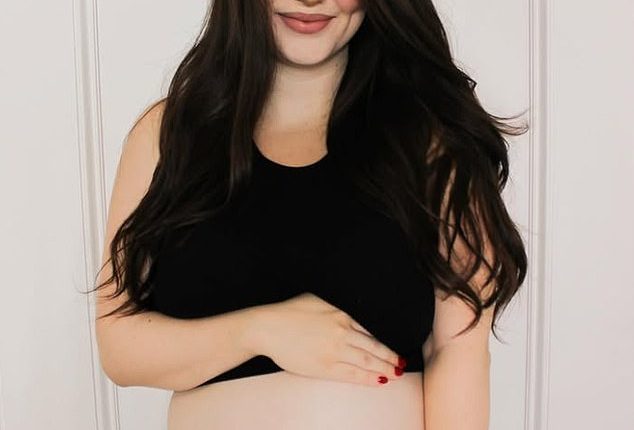A Texas woman who was already pregnant conceived another baby two weeks later in a one-in-a-billion medical anomaly.
Taylor Henderson, 28, a stay-at-home mom from Texas, experienced superfetation, meaning she had gotten pregnant twice within two weeks.
The first embryo was conceived 14 days before the other one, in an event so rare the Cleveland Clinic says, your chance of being affected by superfetation is ‘close to zero’. There are only about 10 confirmed cases in the world.
The shock came eight weeks into her pregnancy during a scan which revealed that there were in fact two babies, both completely different sizes.
The nurse technician suddenly noticed a ‘tiny, little black area with a tiny little baby inside,’ which was later referred to as Twin B.
The growing babies had different heart rates which were consistent with their ages. Twin A, she explained, was eight weeks old, while Twin B, was six weeks old.
Mrs Henderson already had a four-month-old daughter named Sunni and said she and her husband Clayton ‘definitely weren’t trying for another’.
However, she said they both ‘knew there was a slip up’ during sex shortly after welcoming their daughter and that it was a ‘possibility’.

Taylor Henderson, 28, from Texas, was already pregnant but she conceived another baby two weeks later – a one-in-a-billion medical anomaly
Naturally, Mrs Henderson said she and Clayton were ‘just in pure shock’ as they looked at the scan showing two babies, ‘one clearly larger than the other one’.
After having another scan and getting a second opinion from a doctor, Mrs Henderson was diagnosed with superfetation.
Superfetation, which was first defined in 1999, happens when a woman experiences two menstrual cycles back to back, each resulting in a pregnancy.
It happens when a second egg is released, fertilized, and implanted into the uterine lining, even though an embryo from a previous conception is already present.
Superfetation is so rare that researchers don’t have enough data to confirm its causes.
Most cases involve the use of assistive reproductive technologies (ART), which includes fertility treatments like in vitro fertilization (IVF).
This is because these technologies bypass some of your body’s barriers to back-to-back pregnancies, but it’s still extremely unlikely even with those methods.
Mrs Henderson said she had no idea she had gotten pregnant again as there aren’t any symptoms unique to superfetation.

The ultrasound scan showed two fetuses that were different sizes and they had different heart rates which were consistent with their ages

Mrs Henderson said she had no idea she had gotten pregnant again as there aren’t any symptoms unique to superfetation

Taylor pictured with her husband Clayton and their children Sunni and Carter
While Mrs Henderson and her husband were baffled by the diagnosis, the medical team were also surprised.
The mom-to-be’s doctor said she had never seen a case of superfetation in her career and only read about it happening.
In a video posted to TikTok, Mrs Henderson reveals that she found out during a follow-up appointment that she had sadly lost the smaller and youngest baby, Twin B.
She explains: ‘[The baby] had continued to grow at a normal pace, and the heart stopped beating, which stopped the baby’s growth at that point.’
Despite the early complication she gave birth to Twin A, a boy named Carter, in October 2024.
She described the birth as ‘intense’, and her son had to spend 12 days in the NICU before being released home.
The now mom-of-two has since had an IUD inserted as she says she got pregnant the past two Valentine’s Days and wanted to ‘make sure it didn’t happen a third time’.







